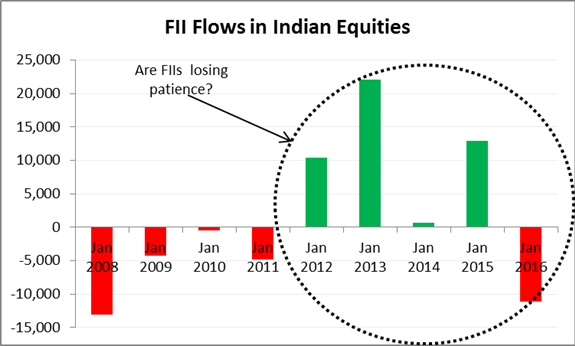In a cricket match, especially in the T20 format, the opening batsman plays a very crucial role. If they get off to a flying start, the chances of their team getting into a commanding position are higher. This is similar to what Foreign Institutional Investors (FIIs) mean for Indian markets. They take the initiative in driving markets up or dragging them down. This year, FIIs might be bearish. They have pulled out Rs 11, 126 crore from Indian markets in January 2016—the largest outflows for the month of January in the last 8 years. Prior to this, the FIIs had shunned Indian equities worth more in January 2008.
Bear Grip...

Data as on January 31, 2016
(Source: ACE MF, PersonalFN Research)
The highest ever monthly outflows were recorded in August 2015, when FIIs had withdrawn Rs 17,000 crore from Indian equities. The outflows recorded in January 2016 have been the second highest in the last 5 years. Such a sharp move in FII activities must have taken many by surprise, a nasty one though. Now the discussion about Indian markets entering a bear phase has started making the rounds in the market’s inner circles. How much merit does such arguments hold? Only time may tell. But the saddest part is
Domestic Institutional Investors (DIIs) and the Indian retail investors still appear complaisant about new developments. Their investments in the Indian markets still remain fairly strong.
The NFO factory of mutual fund houses has been raising money from retail investors. DIIs have roughly invested Rs 12,875 crore in January 2016.
Reading between the lines…
After
keeping the faith in the possibility of a turnaround in the structural story of India for the last 3 years, FIIs have finally started exiting. Massive outflows recorded in August 2015 and January 2016 tells us that they have been selling Indian equities on each rally. They seem convinced there’s no turnaround in India. Of course, the optimistic interpretation is the turnaround that FIIs expected has already happened or at least has been factored into stock prices. As they see no further triggers in the foreseeable future, they have started moving out of India’s markets.
The main concern of FIIs may be the lack of improvement in the companies’ performance. According to the Business Standard update on quarterly earnings, the December quarter of the Financial Year (FIIs), 657 companies have collectively recorded a fall of approximately 0.55% in the revenue While the net profit has jumped to 11.59%, it is largely attributed to the fall in global commodity prices and lower energy prices. The fall in sales exposes the softening demand. As the Government has failed in passing crucial bills such as Goods and Services Tax (GST), FIIs might have become skeptical about the effectiveness of the Government strategies.
Are we heading towards another protracted bear market?
Large FII outflows are the signal of a forthcoming big market movement rather than a result of a market movement. Whether markets will crumble or rise up depends on a number of factors including:
- Progress of the Government on the reform agenda
- Market valuations
- Strength of consumption demand
- Inflation
- Corporate performance
At the moment, barring inflation, the other factors are negative to various degrees. Unless most of them turn positive, FIIs are unlikely to return in a big way. Globally, the economic growth is under pressure and many countries are witnessing an unprecedented fall in their domestic currencies. The global environment is unsupportive, especially for emerging markets such as India.
What retail Indian investors should do?
First, it would be in their best interest to
stop following FIIs and falling prey to fancy marketing gimmicks of mutual fund houses as well. Instead, they should focus on the fundamentals and look at more sophisticated indicators such as market valuations and revenue growth. So far, strong DII flows in India have been keeping markets afloat and every fall is being bought. Retail investors have been bullish too. How long will this last? Nobody knows. Unlike FIIs, DIIs, and retail investors don’t have very deep pockets. If they turn bearish, a major fall will appear to be the writing on the wall.
Don’t lose heart; if you know what to buy when markets fall, you need not be wary of the downtrend.
As the great contrarian investor and British nobleman Baron Rothschild famously said,
“Buy when there’s blood in the streets.”
If you are unsure which companies you should invest in, consider investing in diversified equity funds. Go with those having a dependable performance record across market cycles and timeframes. You may like to try out the
unbiased mutual fund services provided by PersonalFN.
Add Comments